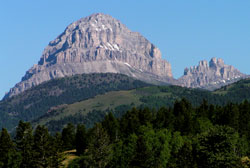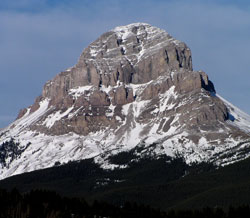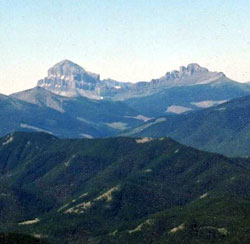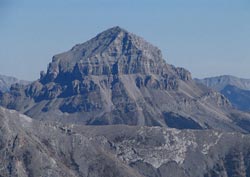
Photo: Looking north to Crowsnest Mountain from Highway #3
Crowsnest Mountain
- 2785 m (9,138ft)
- First Ascent
Located in the Crowsnest River Valley between Allison Creek Valley and McGillivary Creek Valley
Province: Alberta
Headwater: Oldman
Major Valley: Crowsnest
Visible from Highway: 3
Ascent Party: Tom Wilson
Ascent Guide: Christian Hasler sr., Friedrich Michel
"Crowsnest Mountain, seen from the south, stands out as an isolated massif, rising in terraces and resembling a great fortress or keep." -B.C.-Alberta Boundary Survey Report One of the Rockies' "Calendar Peaks," Crowsnest Mountain is a spectacular sight as one drives through the Crowsnest Pass. It stands aloof, in front of the main High Rock Range and this, together with its steep cliffs on all sides, is what makes it so eye catching. With an elevation of 2785 metres, it is the highest of the peaks which form the Panorama from Coleman. Seven Sisters Mountain lies immediately north of Crowsnest Mountain. The earliest written reference to the name is in Thomas Blakiston's journal where he refers to the Crow-Nest River. George Dawson did surveying work in the area on behalf of the Geological Survey of Canada in 1883-1884. He noted that the mountain, as well as the pass and the river, were named by the Cree Indians because of the big black birds which nested in the area. According to "Place Names of the Canadian Alps," the Cree were referring to ravens. Perhaps the name should have been Ravensnest. The steep cliffs of Crowsnest Mountain attracted none other than Edward Whymper, the famed British mountaineer who had been the first to climb the Matterhorn in Switzerland. Whymper, due to a combination of age and alcohol, was well past his prime at this point. Whymper visited the Crowsnest Pass area in 1903 and again in 1904 as part of his efforts to travel in the Canadian Rockies on behalf of the CPR and then to write promotional articles for newspapers and popular journals. Specifically, while in the Crowsnest Pass area, he was to identify suitable locations for the construction of hotels and chalets and also to examine Turtle Mountain that in April of 1903 had been the scene of a tragic slide. It was hoped that Whymper could determine the possibility of future slides. In 1904 Whymper made arrangements with Tom Wilson, the first white man to see Lake Louise, and two Swiss guides (Christian Hasler jr and Friedrich Michel) and they travelled to the vicinity of the unclimbed peak which Whymper "had been given to understand was impossible of ascent." On July 26th, Wilson, Hasler, and Michel made their way to the west side of Crowsnest Mountain where they established a camp. They were to cut a trail around the mountain, examine its features, and then report to Whymper. It appears that Mr. Whymper's "employees" could not resist the temptation to climb the peak and when Whymper arrived on July 29 a telegram from Wilson was waiting that read, "Flag on Crows Nest Mountain. Waiting orders." The mountain had been climbed on July 28th. This may have been one of a number of tricks played on Edward Whymper by a few of the guides and outfitters he engaged. Historian Raymond Huel wrote that, "While the news greatly displeased Whymper there is no conclusive evidence to suggest that this was due to the fact that he had been deprived of the honour of being the first to stand on the virgin summit. . . The most plausible explanation for Whymper's irritation was that his orders hd been disobeyed. Whymper also noted that Wilson had "taken a bottle" and Whymper wondered if this, "had been the cause of the group's irrisponsible behaviour." An article in the Banff newspaper reported, "Mr. Whymper, who had promised himself the addition of another laurel to his crown of fame, reported that, 'the only thing in climbing a difficult mountain is the credit of being the first to accomplish the feat. . .'" The men had been sent ahead to locate the best route of ascent and for some reason were a long time returning. Owing to a breach of faith or perhaps over-enthusiasm on the part of his assistants, Mr. Whymper did not enjoy the distinction of leading the ascent." Whymper was quoted a saying, "I feel much chagrined, the moreso as it was my own men who got there ahead of me." [Fraser] The cliffs forming the upper part of the mountain are limestones of Paleozoic age, while the more gentle slopes below the cliffs are much younger, being of Mesozoic age. Because the rocks at the top are older than the rocks at the bottom some people believe that Crowsnest Mountain is "upside down," and think that it was turned over. Indeed the top is older than the base, but the mountain is not upside down. The cliffs in the upper part of the mountain are part of a sheet of rocks that were once connected with the rocks forming the High Rock Range to the west. The sheet was pushed upward and eastward, riding over the younger rocks that now form the base of the mountain. Beneath the cliffs is the Lewis Thrust Fault which is nearly horizontal, sloping west beneath the cliffs of the High Rock Range. Long after the limestones were pushed eastward on the fault, the streams cut down through it to make the mountains we see today. They cut away around all side of Crowsnest Mountain and left the peak isolated, an island of old rocks sitting on younger rocks. The island of rocks above the thrust fault made Crowsnest Mountain a geologic feature called a "klippe." The ballad on the following page explains the geology and was found in the canister on the summit of Crowsnest Mountain in 1992. Al Bradley is a geologist and, together with his brother Fred, spearheads the "Crow Cavorters," a group which has been meeting each year since 1971 for a weekend of "mountain climbing, caving, and cavorting" in the Crowsnest Pass area. Al's poem was written partly to commemorated the twentieth anniversary of the "Cavorters." THE BALLAD OF THE UPSIDE-DOWN MOUNTAIN There've been strange tales told, by cavorters bold, round the campfire late at night. When cavorting juice, makes the tongue go loose, and all reason takes a flight. The Crowsnest Pass has heard many an ass, spin tall tales about the town. But the best of all, is the one about how, the mountain got turned upside-down. Now I know it seems strange, to those who don't range, the mountains the way I do. But I've been there and by God I swear, that indeed I believe it is true. Now upside-down is a relative noun, whose meaning's not always the same. Is not bottom over top, a logical spot, to end debate on the upside-down claim. For that's what's so on the mountain called Crow, where tectonic upheaval has reigned. The Lewis Thrust has ripped the Earth's crust, to create the present terrain. The rocks at the base are the youngest in place, while the oldest crowd the sky. Now that's upside-down so let's go to town, and drink beer for as long as you buy. -A.R. Bradley P.Geol.

Looking north to Seven Sisters Mountain (left) and Crowsnest Mountain from Mount Ptolemy (courtesy Sonny Bou)
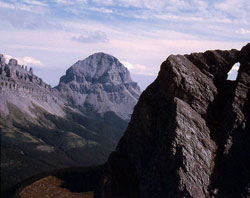
Looking south-southeast to (l-r) Seven Sisters Mountain, Crowsnest Mountain, and Window Mountain (courtesy Edward Michalski)
